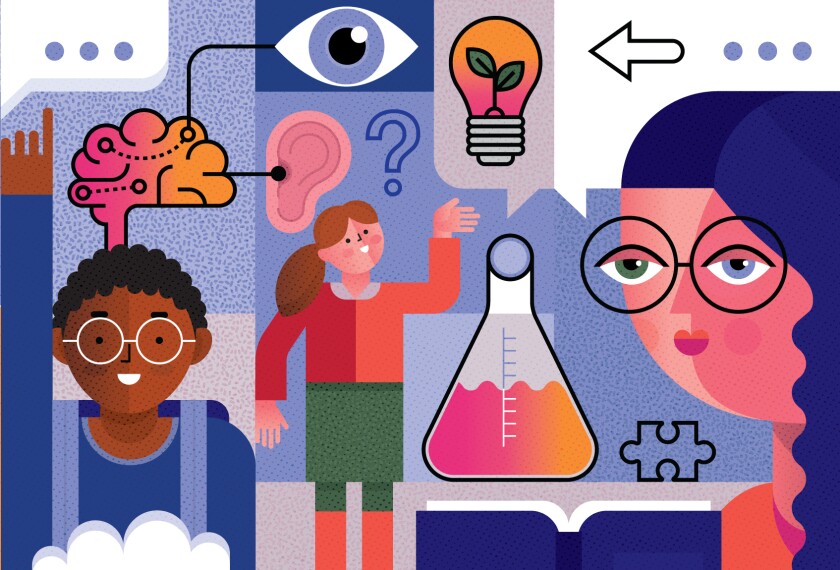During the summer, I am sharing thematic posts bringing together responses on similar topics from the past 11 years. You can see all those collections from the first 10 years here.
Today’s theme is on Science Instruction.
You can see the list following this excerpt from one of the posts:

1. Four Good Science Teaching Strategies & How to Use Them
Three science educators share their go-to teaching strategies, including encouraging student talk and implementing project-based learning. Read more.
2. The Three Most Effective Instructional Strategies for Science—According to Teachers
Three science educators share their favorite instructional strategies, including incorporating a sense of play in their classes. Read more.
3. Ten Culturally Responsive Teaching Strategies for the Science Classroom
Four teachers share how they implement culturally responsive instruction in their science classrooms. Read more.
4. ‘Challenges, Curiosity, Creativity, & Community’ in the Online Science Classroom
Four science educators share online teaching tips, including having students conduct hands-on experiments at home and maintain scientific notebooks. Read more.
5. Science Instruction in the Age of the Coronavirus
Four science educators share their experiences adapting to online instruction, including through collaborative learning and the use of online labs. Read more.
6. Don’t ‘Steal the Aha’ From Science Instruction
Linda Tolladay, Patrick L. Brown, James P. Concannon, Ross Cooper, and John Almarode share their “nominations” for the biggest mistakes made by science teachers. Read more.
7. Ways to Use Tech in Science Class
Erin Bridges Bird, Peggy Harte, Patrick Brown, James Concannon, Nick Cusumano, and Donna Markey share ways to use ed-tech in science classes. Read more.
8. How to ‘Weave Writing Throughout Science Lessons’
Anne Vilen, Sheila Waggoner, ReLeah Cossett Lent, Jason Wirtz, Amy Benjamin, Jennifer L. Altieri, and Fred Ende contribute their suggestions on incorporating writing into science classes. Read more.
9. Ways to Integrate Writing Into Science Classes
Mary K. Tedrow, Amy Roediger, Maria Grant, Diane Lapp, Ed.D., Mandi White, Tara Dale, and Becky Bone share their suggestions for how to integrate writing into science classes. Read more.
10. ‘The Biggest Challenge to Science Teachers Is Time’
Alfonso Gonzalez, Mike Janatovich, Anne Jolly, and Camie Walker share what they think are the biggest challenges facing science teachers today. Read more.
11. ‘Give Me Longer Class Periods and More Space,’ Science Teacher Pleads
Anne Vilen, Marsha Ratzel, Charles R. Ault Jr., and AJ Sisneros contribute their ideas on the biggest challenges faced by science teachers. Read more.
12. Teaching ELLs That ‘Science Is a Verb’
Maria Grant, Diana Lapp, Judy Reinhartz, Lori Fulton, Brian Campbell, and Laura Cabrera contribute their ideas on using the Next Generation of Science Standards with English-language learners. Read more.
13. Teaching Science to English-Language Learners
Alicia Johal, Maria Montalvo-Balbed, Donna Barrett-Williams, Caleb Cheung, Laura Prival, Claudio Vargas, and Ariane Huddleston share their suggestions on using the NGSS with English-language learners. Read more.
14. Response: With 3D Printers, ‘You’re Only Limited by Your Imagination!’
Laura Blankenship, David Malpica, David Thornburg, and Terry Graff have contributed commentaries on the role of 3D printers in the Maker Movement. Read more.
15. The Maker Movement Can Give Students ‘a Story to Tell’
Tanya Baker from the National Writing Project discusses implications the Maker Movement has for different content areas, National Teacher of the Year Jeff Charbonneau elaborates further on its connection to STEM, and Leslie Texas and Tammy Jones make a connection to project-based learning. Read more.
16. The Maker Movement Believes in ‘Kid Power’
Sylvia Libow Martinez and Gary S. Stager graciously adapted a portion of their book, Invent To Learn: Making, Tinkering, and Education in the Classroom, into a piece for this blog. Read more.
17. A Nobel Laureate Writes About Becoming a ‘Science Coach’
Carl Wieman, winner of the Nobel Prize in Physics in 2001 and well-known for his advocacy of cooperative and engaging methods for teaching science, shares his thoughts. Read more.
18. Teaching Science by ‘Thinking Big’ and ‘Being Audacious’
Linda Shore, director of the Exploratorium Teacher Institute, and high school science teacher Amy Lindahl offer their responses in this post. Read more.
19. Teaching Science by “Becoming a Learner”
High school physics teacher Frank Noschese, middle school science teacher Paul Cancellieri, and Steve Spangler, well-known teacher-trainer and creator of science multimedia tools, respond to the question here. Read more.
20. Teaching Science by Asking Questions
Middle school science teachers Marsha Ratzel and Paul Bruno share their responses in this piece. Read more.
Explore other thematic posts:
- It Was Another Busy School Year. What Resonated for You?
- How to Best Address Race and Racism in the Classroom
- Schools Just Let Out, But What Are the Best Ways to Begin the Coming Year?
- Classroom Management Starts With Student Engagement
- Teacher Takeaways From the Pandemic: What’s Worked? What Hasn’t?
- The School Year Has Ended. What Are Some Lessons to Close Out Next Year?
- Student Motivation and Social-Emotional Learning Present Challenges. Here’s How to Help
- How to Challenge Normative Gender Culture to Support All Students
- What Students Like (and Don’t Like) About School
- Technology Is the Tool, Not the Teacher
- How to Make Parent Engagement Meaningful
- Teaching Social Studies Isn’t for the Faint of Heart
- Differentiated Instruction Doesn’t Need to Be a Heavy Lift
- How to Help Students Embrace Reading. Educators Weigh In
- 10 Strategies for Reaching English-Learners
- 10 Ways to Include Teachers in Important Policy Decisions
- 10 Teacher-Proofed Strategies for Improving Math Instruction
- Give Students a Role in Their Education
- Are There Better Ways Than Standardized Tests to Assess Students? Educators Think So





